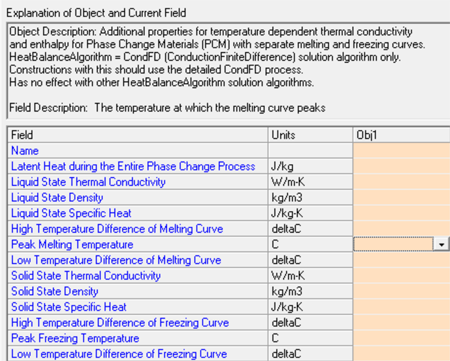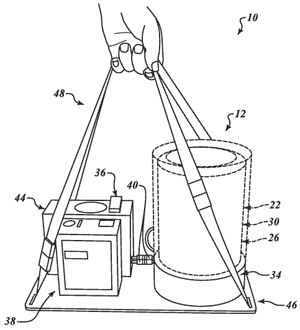 The Phase Change Matters e-mail newsletter is a weekly summary of the latest news and research on phase change materials and thermal energy storage. To subscribe, visit www.puretemp.com/subscribe. For more frequent updates, follow @puretemp on Twitter or visit the Phase Change Matters blog, www.puretemp.com/pcmatters.
The Phase Change Matters e-mail newsletter is a weekly summary of the latest news and research on phase change materials and thermal energy storage. To subscribe, visit www.puretemp.com/subscribe. For more frequent updates, follow @puretemp on Twitter or visit the Phase Change Matters blog, www.puretemp.com/pcmatters.
SOFTWARE
New version of EnergyPlus features updated PCM module
The latest version of EnergyPlus modeling software includes an updated module for measuring the impact of phase change material on energy use in buildings.
Developed by the U.S. Department of Energy, EnergyPlus is an energy simulation program that can be used to calculate heating and cooling load in a building, based on detailed information about the building’s physical make-up and mechanical systems.
With the support of a $100,000 grant from the Department of Energy, Jeremiah Crossett, chief technology officer of NRGsim Inc., worked with Dr. Edwin Lee of the National Renewable Energy Laboratory to incorporate the updated PCM module into EnergyPlus.
The PCM module was originally developed more than five years ago by Ramprasad Chandrasekharan, then a graduate student in mechanical engineering at Oklahoma State University. Crossett assumed responsibility for the module soon after, debugging the FORTRAN code and modifying the logic to include the effects of subcooling and hysteresis. He began using the module in a customized version of EnergyPlus on all PCM modeling projects he worked on. The module, however, was not compatible with public versions of EnergyPlus, which was converted to the C++ programming language in 2014.
 Crossett, right, sought the DOE grant to fund the conversion of the PCM module to C++ so that it could be incorporated into EnergyPlus. The module features two major improvements to the original PCM module.
Crossett, right, sought the DOE grant to fund the conversion of the PCM module to C++ so that it could be incorporated into EnergyPlus. The module features two major improvements to the original PCM module.
“The new model includes the effects of hysteresis,” Crossett said. “The input object is called Material Property Phase Change Hysteresis and includes two [temperature/enthalpy] curves. Instead of going up and down in the slope of a single curve, the model either stores the energy in the storage range and then releases it when the model hits the heating curve. Or the model hits the heating curve immediately, depending on the properties of the actual phase change material. This model takes into account the histories of building surface temperatures, on into the current. It does a better job of accounting for the phase change material’s performance over time.
“In the previous version, what would happen is any time temperatures would fall and then rise again, and rise and then fall again, any time temperatures were not fully linear, [the module] would show additional energy consumption. Essentially, you had this single curve and as it would get cooler it would drop the heat back into the space. So say your material’s melting at 74, 75 Fahrenheit, and you’re saving on cooling energy, and then it drops down to 73, and now it drops all the heat right back into the space. So now you’ve got more energy you’ve got to deal with in your cooling system. That’s not how it actually works in the real world. …
“That caused a whole lot of studies, done by many, many different people over the years, to be wrong. It essentially gave a false indication that phase change materials don’t work nearly as well as they really do. …
“[The new module also] models subcooling and supercooling. Each PCM has a theoretical melt and freeze point. That’s normally how these products are rated. Some companies call it a Q-value. Other companies just say it as a number, such as a phase change 23 or a phase change 29 in degrees Celsius. But in the real world, how these products actually perform is that there’s some amount of subcooling: the freezing point is not identical to the melting point. You can have supercooling as well, where once your material is frozen, you have to reach a point above the theoretical melting point in order to melt it. This model allows the thermal simulation to have different melting and freezing points. …
“Now that EnergyPlus can accurately model PCM’s performance in real buildings,” Crossett said, “it is well-suited for evaluation of PCM technologies for energy codes such as California’s Title 24 and green building standards such as ASHRAE 189.1.”
Here’s a screen grab of a portion of the new EnergyPlus PCM module:

Crossett and Lee completed work on the module in August. Version 8.8.0, released on Sept. 30, is available for free at https://energyplus.net/downloads. They plan to publish a paper on their work later this year.
Over the next six months NRGsim plans to work with PCM manufacturers to add their products to a database for the EnergyPlus program, based on the ASTM C1784-14 protocol, “Standard Test Method for Using a Heat Flow Meter Apparatus for Measuring Thermal Storage Properties of Phase Change Materials and Products.”
PATENTS
Refrigerated container
U.S. patent application 20170292759 (applicant XALT Energy (Midland, Mich.):
“A transport vehicle having a refrigerated container and system of refrigeration is provided. … The reefer, system, and method according to the present invention is also related to a reefer, system, and method having a plurality of energy supply units each having a battery, an electric compressor along with a condenser and evaporator and/or a heat pump, a system of tubes carrying a refrigerant, a refrigerant, sensors and a controller, and potentially having an engine exhaust system generator and or a panel having a phase change material.”
Portable device for cold chain storage
 U.S. patent application 20170290741 (applicant Tokitae LLC, Bellevue, Wash):
U.S. patent application 20170290741 (applicant Tokitae LLC, Bellevue, Wash):
“Disclosed embodiments include portable devices for cold chain storage and methods of fabricating portable devices for cold chain storage. In an illustrative embodiment, a portable device for cold chain storage includes a container defining therein a storage region. The container includes an inner cylinder, and the storage region is defined coaxially inwardly of the inner cylinder. The inner cylinder includes phase change material disposed therein, and the phase change material is in thermal communication with the storage region. The inner cylinder also includes evaporative coils disposed therein. The evaporative coils are embedded in the phase change material. The container also includes a thermally insulated outer cylinder. An outer wall of the outer cylinder is disposed radially outwardly of an outer wall of the inner cylinder.”
Support tooling for composite parts
U.S. patent application 20170291404 (applicant Boeing Co., Chicago, Ill.):
“Systems and methods are provided for forming composite parts. One embodiment is an apparatus that includes a forming tool. The forming tool includes a body, which includes an exterior that defines a shape for forming a laminate that will be cured into a composite part. The body also includes elements of phase change material that provide rigidity to the body below a threshold temperature, and that exhibit a phase change above the threshold temperature causing the body to become pliable. Further, the body includes flexible material that encloses the elements of phase change material.”
IN BRIEF
• SaltX Technology has been awarded Sweden’s E-Prize, presented by European energy company E.ON and Swedish business magazine Veckans Affärer. SaltX won the category “Renewable Energy” as well as the “People’s Award.” SaltX’s nano-coated salt energy storage technology is used in EnerStore, the company’s large-scale energy storage system for heat and power generation.
• Brooks Danahy, a senior majoring in chemical engineering, is one of 13 University of Kansas students to receive a $1,000 Undergraduate Research Award. His project: “Characterization of Melting Point Depression and Phase Change Behavior in Ionic Liquid + Compressed Gas Systems.”
• California startup Axiom Exergy, maker of a “Refrigeration Battery” designed to reduce supermarket energy costs, has posted an opening for a field engineer.
• Registration is open for a SpecialChem online course, “Essential Concepts for Optimal Compounding,” to be held on Nov. 2. The cost for three attendees on one connection is 300 euros.
• The Atlantic‘s Derek Thompson got a virtual peek inside X, the secretive lab where Google‘s parent company is researching advanced technology. Current projects include salt-based thermal storage, which X believes could become the cheapest grid-scale storage technology in the world.
• A ceramic-based mechanical pump developed at Georgia Tech is able to operate at record temperatures of more than 1,400º Celsius, expanding the range of materials that can be used in high-temperature thermal storage systems. “The hotter we can operate, the more efficiently we can store and utilize thermal energy,” said Asegun Henry, an assistant professor in Georgia Tech’s Woodruff School of Mechanical Engineering. “This work will provide a step change in the infrastructure because now we can use some of the highest-temperature materials to transfer heat. These materials are also the hardest materials on Earth.”
• Schneider Electric of Andover, Mass., says augmented reality and mixed reality training regimens will become increasingly important at chemical plants as advances occur in both hardware and software.
RESEARCH ROUNDUP
For our full list of recent academic research, see puretemp.com/academic. Here are highlights from the past week:
From Renewable and Sustainable Energy Reviews:• Experimental set-up for testing active and passive systems for energy savings in buildings – Lessons learnt
• Review on thermal conductivity enhancement, thermal properties and applications of phase change materials in thermal energy storage
From Journal of Energy Storage:
• Preparation and thermal performance of methyl palmitate and lauric acid eutectic mixture as phase change material (PCM)
From Applied Thermal Engineering:
• A novel heat transfer model of a phase change material using in solar power plant
From Energy Procedia:
• Experimental investigation of flow rate impact on thermal accumulation system with PCM
From Energy Conversion and Management:
• Experimental and numerical investigation on the performance of carbon-based nanoenhanced phase change materials for thermal management applications
From International Journal of Thermal Sciences:
• Thermal management of lithium ion batteries using graphene coated nickel foam saturated with phase change materials
From Applied Energy:
• Preparation of novel copper-powder-sintered frame/paraffin form-stable phase change materials with extremely high thermal conductivity
• Experimental investigations of charging/melting cycles of paraffin in a novel shell and tube with longitudinal fins based heat storage design solution for domestic and industrial applications
• A novel thermoelectric harvester based on high-performance phase change material for space application
From Sustainable Cities and Society:
• Experimental Investigation of Phase Change Materials for Insulation of Residential Buildings
• A comparison of battery and phase change coolth storage in a PV cooling system under different climates
NETWORKING
Connect with PCM experts and industry leaders on LinkedIn
More than 1,150 people have joined a LinkedIn group devoted to the discussion of phase change material and thermal energy storage. The Phase Change Matters group is an interactive complement to the award-winning blog and newsletter of the same name.
 You are invited to join the group and connect with PCM and TES experts from around the world. New members include Chris Donaghy, director of energy technologies, Croda, Edison, N.J.; Jessica Gamble, director of marketing at Phase Change Energy Solutions Inc., Asheboro, N.C.; Anne Laure Revelli, thermodynamics engineer at Processium, Villeurbanne, France; and Muhammad Shahid, a student at the University of Management and Technology, Lahore, Pakistan. Muhammad poses a fairly broad question:
You are invited to join the group and connect with PCM and TES experts from around the world. New members include Chris Donaghy, director of energy technologies, Croda, Edison, N.J.; Jessica Gamble, director of marketing at Phase Change Energy Solutions Inc., Asheboro, N.C.; Anne Laure Revelli, thermodynamics engineer at Processium, Villeurbanne, France; and Muhammad Shahid, a student at the University of Management and Technology, Lahore, Pakistan. Muhammad poses a fairly broad question:
“I am a student of mechanical engineering. Currently we are doing our final year project on a solar still in which some type of phase change material is to be used. My question is: Which PCM is suitable for a solar still? Please mention by proper name.”
Perhaps this paper, published Oct. 10 in the journal Desalination, will be of use: “Factors influencing the performance and productivity of solar stills – A review.”